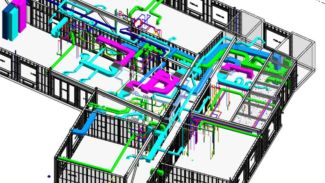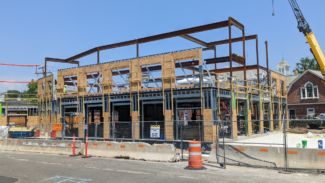Small-scale roll forming machines are specialized pieces of equipment making a big impact in cold-formed steel and construction — but are they worth it? Keep reading as we explain exactly how they work, plus the pros and cons, so you can make an informed decision if you’re considering a purchase.
- What is a Roll Forming Machine?
- How Do Roll Forming Machines Work?
- The New Small-Scale Roll Form Machine Process
- BIM Connectivity
- Pros & Cons of Small-Scale Roll Form Machines
- How New Technology Has Improved Roll Forming
- FAQs
What is a Roll Forming Machine?
A roll forming machine is a large device that receives strips of steel, usually on a coil, and uses a series of dies to bend steel into a desired shape or cross-section. These heavy machines can bend, cut, punch, and stamp the steel. They are extremely loud and require a significant power supply and scheduled maintenance.
How Do Roll Forming Machines Work?
First, a metal stud manufacturer buys a large coil of raw steel from a steel plant or distributor. The coil is typically 4–5’ in diameter and 4-5’ wide.
The manufacturer cuts the roll of raw material into widths that will accomodate the dimensions of the desired material cross-section. (For example a 6-inch metal stud with 2-inch flanges and ½-inch lip returns will have a ‘slit’ width of 11 inches.)
The next steps are the same, regardless of whether you have an industrial or small-scale roll forming machine: Each sheet of cut steel is passed through the roll forming machine, moving through a series of rollers that progressively bend, mold, and punch the steel into a desired shape.
The machine molds the sheet metal at room temperature with no heat required.
Roll forming machines today feature computer-aided tools that allow for more precision and accuracy. These large scale machines can often handle a wide variety of steel thicknesses (gauges) and stud dimensions.
The Small-Scale Roll Form Machine Process
Larger manufacturers, such as ClarkDietrich, have industrial or commercial-level roll forming machines, while smaller scale companies typically use personalized machines made by FRAMECAD, Howick, or other manufacturers. Both large and small machines have the same purpose and process; the small-scale machines, however, only roll forming for a narrow range of stud sizes and gauges — far less than the industrial-level machines.
Industrial-level machines also have restrictions but typically offer more flexibility in terms of material size and gauge, which means they are more expensive and may be more difficult to operate and maintain. Small-scale roll forming machines may be a better fit for mid-to-large contractors with the exception of a large-scale load bearing panelizer.
By offering entry-level machines and a variety of payment options, FRAMECAD and Howick also make buying these types of machines more affordable.
BIM Connectivity
The biggest innovation in these small-scale rolling machines is the connectivity with the design software. The machines aren’t just producing construction material; they are producing materials that are cut, trimmed, and drilled to a specific size for a specific location on the project. It would be common to see every piece leaving a small-scale roll forming machine to be different than the one preceding it. The process nearly eliminates all field cutting.
There are a few software manufacturers that provide standalone or add-ons to Revit®, AutoCAD®, Tekla®, Microstation®, and others. All of them operate under the principle that the project is drafted and the data from the project is compiled into an .icf file. These machines read the .icf file and produce a cut list of material to form. When the process is running smoothly, the end product is efficient and elegant. However, it can be tricky to get the .icf file produced by the drafting software to be free of errors for the machines to read properly. Some pairings of software and manufacturers work better than others.
Pros and Cons of Using a Small-Scale Roll Forming Machine
It’s important to consider both the advantages and disadvantages of these types of machines. Here are some of the most common:
Pros
- Your CAD designs can be directly integrated into your machine software and produce stud sizes/shapes specifically for your project.
- Cutting is eliminated.
- You can create your own stud shapes instead of following Steel Stud Manufacturers Association (SSMA) guidelines.
- You are not limited to the availability of your stud supplier, which during supply-chain issues can extend from weeks to months.
- You have the ability to produce precise, uniform pieces that are both extremely short or extra-long.
- The process is efficient, sustainable, and adjustable.
Cons
- The software can be difficult to operate and doesn’t always cleanly translate design drawings to fabrication drawings.
- Buying large, uncut rolls of steel can be difficult, especially since steel plants typically target large-scale manufacturers that buy in bulk. In turn, those large manufacturers may sell steel to smaller contractors, but at a marked-up price.
- Small-scale roll forming machines can be expensive, and they need adequate space inside a facility and proper maintenance to perform correctly.
- The process isn’t ideal for small production runs.
How New Technology Has Improved Roll Forming
Construction, like most industries, has continued to shift and evolve over the years, and the future looks to change even more: A recent report from McKinsey, “The next normal in construction” predicts that “about 41 percent of the current U.S. construction workforce is expected to retire by 2031.” In order to keep moving up with demand, construction will need to move toward a more pre-fabricated, automated process with advanced technology and software that allows for a smaller workforce. These small-scale rolling machines are designed to eliminate the need for a portion of the construction workforce. The on-site construction staff can be eliminated with these machines and instead only a small erection crew is needed. This will help fill the personnel void left by those retiring.
FAQs
Q: What is a roll forming machine?
A type of machine that takes flat strips of steel and progressively bends the steel into a desired shape and length. This process is done at room temperature as opposed to hot-rolled steel which uses a progressive series of dies to form heated steel into a desired shape.
Q: Should I consider buying a machine?
Many mid-size contractors have found success with small-scale roll forming machines while others have not. Before purchasing this type of equipment, we recommend doing as much research as possible and visiting successful operations. It still is a large capital investment.
Questions? Need More Information?
We have experience with designing structures and providing the files specifically for small-scale roll forming machines.If you have any questions or would like more information, contact us today.

